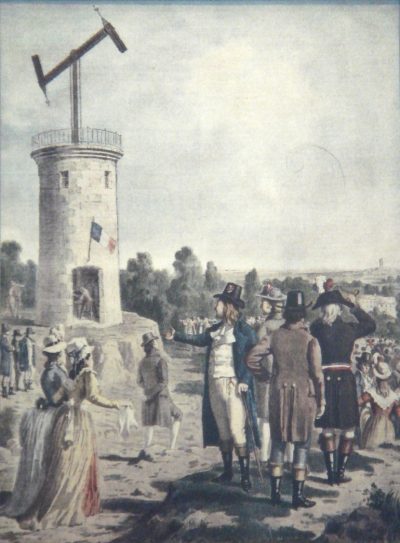On Patricia Crain’s “Children of Media, Children as Media”

Media do more than relay messages — they can wield power over perceptions, relationships, and people. Patricia Crain’s essay “Children of Media, Children as Media” illustrates this point. Crain shows how the idea of the optical telegraph, a media innovation of the French Revolution, influenced new theories of childhood education that spread far beyond use of the telegraph itself. At American Indian mission schools in the nineteenth century, the metaphor of the optical telegraph promised to discipline Indian children into messengers of white “civilization,” becoming an instrument of colonial power.
A distant precursor to the electric telegraph, optical telegraphs rose like mutant windmills across the countryside of Revolutionary France in the 1790s. Each optical telegraph featured large mechanical shutters that moved into various positions to display semaphore code. French semaphore lines located a telegraph tower every ten kilometers (6 miles), allowing operators with telescopes to receive and then replicate short messages down the line faster than a rider on horseback. By the early 1800s, semaphore lines linked Paris to most major French cities, speeding long distance communication and linking the nation under centralized military command. Optical telegraphs saw more limited use outside France, but Patricia Crain argues that the idea of the visual telegraph in public discourse had wider influence than its actual implementation.
For Joseph Lancaster, an English educational reformer, the metaphor of the visual telegraph held the key to making public education more efficient and widespread. Rather than small classes of students working closely with a teacher, Lancaster proposed the “Monitorial System,” which allowed a single schoolmaster to supervise hundreds of students by appointing advanced pupils as “monitors” to replicate lessons for smaller study groups. Lancaster recommended spacing these groups throughout a large hall around instructional posters that replaced textbooks and allowed many students to share simultaneously in a lesson. A simplified visual “telegraph” made of cards bearing short commands such as “SS” for “Show Slates” allowed the schoolmaster to quickly send instructions throughout the class. Obedience was rewarded with prizes, while those who disobeyed faced public shaming by wearing labels that telegraphed their misdeeds to their peers.